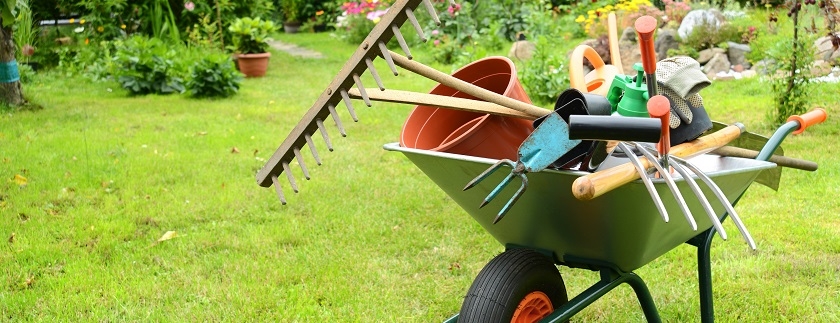Those of you with green fingers will soon be gearing up to tend to your Spring garden. Whether you’ve got a rockery, raised beds or a full orchard, you’ll need a variety of garden tools. This guide helps you separate your spades from your shovels and your rakes from your hoes as well as telling you some essential kit every gardener should own.
Shears / Loppers / Pruners
A cutting tool is essential for gardening, but there are many different types designed to tackle different issues. Hedge shears have a long straight edge allowing for precision and shaping, whereas lopping shears are needed for small branches and have long handles so that you can apply the appropriate force. Pruners can be either saw shaped or secateurs, the saw pruner has a bevelled edge for larger branches, whereas secateurs are smaller and can be held in one hand for precision cuts.
Bowsaws
A bowsaw is designed for the pruning of trees and large shrubs – around 6 inches width maximum. Most have a bevelled edge which means the saw does the work instead of you. They can be used for all general wood cutting, and the bow shape of the saw allows for an ergonomic movement.
Fork
Garden forks can either be ‘hand forks’ - small and held in a single hand, or larger digging forks. The variety in forks tends to be in their shape, handle material and number of prongs. Generally, the more prongs or ‘tines’ the more heavy-duty the work. A good digging fork would have 4 tines, and 3 tine forks tend to be for hay or straw. Small forks are often used for borders when you need precision.
Trowel
Hand trowels are used for breaking up earth, digging small holes, for planting and weeding, mixing in fertiliser or other additives, and transferring plants to pots. They can have different length handles for comfort.
Spade & Shovels
The main difference between a spade and a shovel is the shape of the head. A spade has a flat head with square edges, a shovel tends to be angled with a curved blade head. Spades are great for digging up and breaking apart soil, as well as scooping up material. Shovels is better for slicing through soil, particularly useful for lawn edges and for skimming/slicing weeds and roots.
Rake
Even the modest rake comes in different shapes and designs to tackle different materials, and you’ll notice the difference if you use a normal rake vs a leaf rake, for instance. For heavier material go for a road rake which has supporting shafts for better control. The rake head can be curved or straight, with curved better for softer materials.
Hoe
The hoe is the tool you never realised you needed until you use it. Primarily designed for the top level of soil, it will help you clear weeds easily. A new hoe will have sharp edges, and many are designed with blades on both sides so you can move it both forwards and backwards to cut the roots of the weeds.
Wheelbarrows
Wheelbarrows are designed to help you move large quantities, whether that’s earth, rubble or leaves, they are an essential tool for the garden. Wheelbarrows all have a distinctive design element – a single wheel at the front. This allows for easy manoeuvre in any direction, which can be helpful if you have a heavy or stacked load.
Picks
Picks and mattocks have been developed for use in difficult digging in hard ground, such as clay or ground full of rocks. Its design has tempered points so it can get in between material and release it.
Gardening Accessories
Now you have all the essential hand tools, the skilled gardener will have a few other bits in their kit. Twine is useful for tying and supporting plants. It can be used to separate areas of your garden and also to train branches to grow in a certain direction. Canes are useful for similar reasons. They’ll help strengthen the stem of baby shoots and allow plants to grow up and straight. Add some cane accessories to keep your canes in place. Shrub and tree ties are also fantastic to keep branches and stems in place. Also keep in your kit plant labels to help you remember what you planted!



